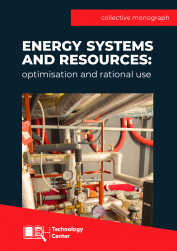Scientific and technical solutions for the implementation of biomass burning at coal-fired thermal power plants of Ukraine
Keywords:
Silicon, magnetic field, doping, crystal lattice defects, solar concentrators, alternative energy, production automation, municipal solid waste, refuse-derived fuel, thermal decomposition, energy efficiency, co-firing, biomass, greenhouse gas emissions, energy balance, convective drying, environmental safety, crystalline structure, phase transformations, computer modelingAbstract
The purpose of the study is to develop a technology for co-combustion of coal and biomass that will reduce CO2, SO2, NOx, and dust emissions, as well as diversify fuel sources for TPPs in order to meet the standards for reducing pollutant emissions and solve problems with coal supply to power plants, and improve the conditions for coal ignition in the combustion chamber.
The article provides an overview of biomass combustion and gasification technologies and their application for co-combustion with coal, and the possibility of their use in boiler units of thermal power plants in Ukraine. The co-combustion of pulverised coal of G grade (gas) and heterogeneous biomass was experimentally investigated. A zone-by-zone thermal calculation of the boiler unit was performed when feeding biomass with coal. Co-combustion of coal with biomass was calculated using ANSYS FLUENT for the selected solution of the biomass feeding system to the boiler fuel chamber. Recommendations for the application of co-combustion of gas group coal and heterogeneous biomass at Ukrainian TPPs are given.

ENERGY SYSTEMS AND RESOURCES: OPTIMISATION AND RATIONAL USE
Downloads
Pages
Published
Categories
License

This work is licensed under a Creative Commons Attribution-NonCommercial-NoDerivatives 4.0 International License.

